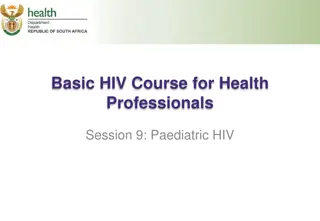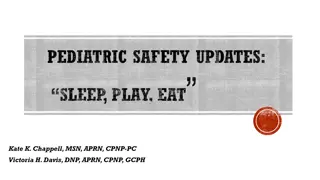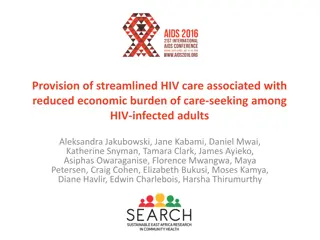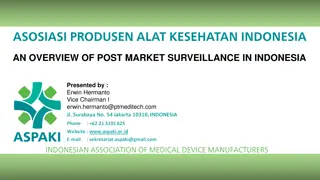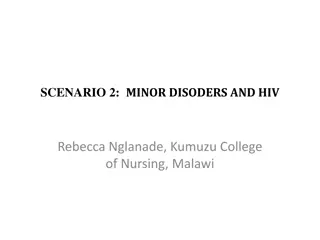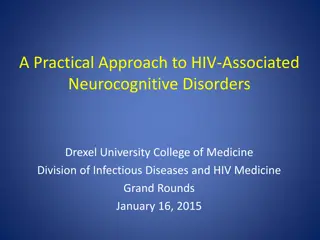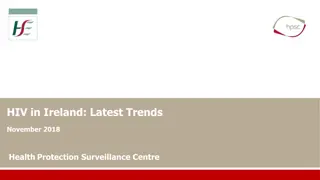Optimizing Early Infant HIV Diagnosis Through Point-of-Care Testing Post-Market Surveillance
Optimizing early infant HIV diagnosis is crucial for public health. Post-market surveillance ensures the safety of medical devices, balancing therapeutic advancements with public health safeguards. The WHO's Medical Device Unit prioritizes access to devices in low-resource settings, emphasizing dissemination of innovations and biomedical personnel training. Two types of post-market surveillance exist: reactive and proactive, each focused on monitoring adverse events and ensuring product reliability. Stakeholder responsibilities and transparency vary globally, highlighting the need for continuous evaluation and safety measures.
Download Presentation

Please find below an Image/Link to download the presentation.
The content on the website is provided AS IS for your information and personal use only. It may not be sold, licensed, or shared on other websites without obtaining consent from the author. Download presentation by click this link. If you encounter any issues during the download, it is possible that the publisher has removed the file from their server.
E N D
Presentation Transcript
Optimizing Early Infant HIV Diagnosis through the Introduction of Point of Care Testing Post-Market Surveillance Case Study Lesotho, October 2017
Post Market surveillance Post-marketing surveillance (PMS) (also post market surveillance) is the practice of monitoring the safety of a pharmaceutical drug or medical device after it has been released on the market and is an important part of the science of pharmacovigilance.
Why ? Devices offer opportunities for improved diagnosis and management of disease, they also can carry substantial risks. Gvt & Regulatory bodies need to balance the goals of expanding therapeutic options with safeguarding public health In recognition of the importance of medical devices, the WHO established a Medical Device Unit focus research and policy on prioritizing access to medical devices in low-resource settings Dissemination of innovations, and Training of biomedical personnel to support the use of devices worldwide
Reactive Post-market Surveillance Complaint reporting, including vigilance of mild, moderate and severe adverse events Evaluation of data from external quality assessment schemes (proficiency testing) End-user quality control programmes.
Proactive Post-market Surveillance Activities Lot verification testing (pre-distribution and post- distribution to end-users). Lot verification testing aims to identify any catastrophic product failure and to determine variation from lot to the next. Lots may either be consecutively or randomly sampled for testing on a panel of well-characterised biological specimens.
evaluated strategies for PMS of medical devices in the United States, European Union, Japan, and China. Several common elements, including primary reliance on passive adverse event collection for marketed devices, but vary widely in their allocation of stakeholder responsibilities and mechanisms for evaluating the performance and safety of approved devices. Greater system transparency, scheduled re-examination of approved devices, and balancing central and local control
Key features of four device post-market surveillance systems Daniel B et al, 2013, Plos Medicine https://doi.org/10.1371/journal.pmed.1001519.t001
Example of IQC failures analysis reporting in Lesotho Sources IQC failure Incident log at testing site WhatsApp group of Qaulity Assurance Officers and users IQC failure, Invalid and No Result Analysis Report Maintenance log
IQC Failure, Invalid And No Result Analysis Report Instrument Date Years (All) (Multiple Items) 2017 Count of Test Result Error code Row Labels Likotsi Filter Clinic Mafeteng Hospital Maluti SDA Hospital Maputsoe SDA Seboche Hospital Grand Total 1006 1 2005 2037 2096 2097 2126 5002 5011 5016 12002 23204 23205 24100 (blank) 5007 5015 18004 23207 no error code Grand Total 1 2 1 7 1 5 2 5 1 20 1 1 8 1 2 6 2 2 2 1 1 1 7 2 8 4 37 1 2 6 3 15 44 16 13 7 95 1 3 1 2 8 1 1 2 1 1 4 2 1 4 3 2 1 8 ERROR, INVALID AND NO RESULT ANALYSIS REPORT Site Mafeteng Hospital GeneXpert Mafeteng Hospital GeneXpert Mafeteng Hospital GeneXpert Mafeteng Hospital GeneXpert Seboche Hospital GeneXpert Maluti SDA Hospital GeneXpert Maluti SDA Hospital GeneXpert Maluti SDA Hospital GeneXpert Likotsi Filter ClinicGeneXpert Likotsi Filter ClinicGeneXpert Likotsi Filter ClinicGeneXpert 8/21/2017 INVALID InstrumentDate Test Result Description 8/1/2017 INVALID 8/4/2017 INVALID 8/8/2017 INVALID 8/8/2017 INVALID 8/8/2017 INVALID 8/1/2017 INVALID 8/3/2017 INVALID 8/7/2017 ERROR 8/8/2017 INVALID 8/8/2017 ERROR Detail Error 5016: Failed to verify valid background error for analyte [SPC]. The RMS error of 3.9 was above the maximum of 3.0 5016 Repeated with leftover sample in B4 and passed Post-run analysis error Error 5016: Failed to verify valid background error for analyte [SPC]. The RMS error of 4.1 was above the maximum of 3.0 5016 Repeated with leftover sample in B1 and passed Post-run analysis error Error 5016: Failed to verify valid background error for analyte [SPC]. The RMS error of 6.9 was above the maximum of 3.0 5016 Repeated with leftover sample in B2 and passed Post-run analysis error Error 5016: Failed to verify valid background error for analyte [SPC]. The RMS error of 12.1 was above the maximum of 3.0 5016 Repeated with leftover sample in B2 and passed Post-run analysis error Error 5016: Failed to verify valid background error for analyte [HIV-1]. The RMS error of 4.2 was above the maximum of 3.0 5016 Caregiver contacted002786 Ithabeleng Lesaoana Post-run analysis error Error 5016: Failed to verify valid background error for analyte [SPC]. The RMS error of 3.4 was above the maximum of 3.0 5016 Repeated with leftover sample in module A3 and passed Post-run analysis error Error 5016: Failed to verify valid background error for analyte [SPC]. The RMS error of 3.3 was above the maximum of 3.0 5016 Repeated with leftover sample in module A4 and passed Post-run analysis error Error 5011: Signal loss detected in the amplification curve for analyte [HIV-1]. 64.2 decrease in signal with 20.7 % degrees at cycle 25 5011 Repeated with leftover sample in module A1 and passed Post-run analysis error Error 5016: Failed to verify valid background error for analyte [SPC]. The RMS error of 12.1 was above the maximum of 3.0 5016 Repeated with leftover sample in A4 and passed Post-run analysis error Error 5011: Signal loss detected in the amplification curve for analyte [HIV-1]. 55.2 decrease in signal with 21.1 % degrees at cycle 30 5011 Repeated with leftover sample in A1 and passed Post-run analysis error Error 5016: Failed to verify valid background error for analyte [SPC]. The RMS error of 12.1 was above the maximum of 3.0 5016 Repeated with leftover sample in A4 and passed Error CodeCorrective Action Sample ID User Module Addressed? (Y/N) Comments (if any) Y Repeat sample HIV-1 NOT DETECTED 001419 Nthabeleng Sesheme B4 Y Repeat sample HIV-1 NOT DETECTED 000433 Nthabeleng Sesheme B2 Y Repeat sample HIV-1 NOT DETECTED 001211 Nthabeleng Sesheme B1 Y Repeat sample HIV-1 NOT DETECTED A3 N Repeat sample clotted, caregiver informed, sample not yet retaken. Sample redrawn and resulted HIV-1 NOT DETECTED on 10/08/17 as sample ID 002787 in module A3 004803 Malillo Sepiriti A2 Y Repeat sample HIV 1 NOT DETECTED 002220 Malillo Sepiriti A1 Y Repeat sample HIV 1 NOT DETECTED 001030 Malillo Sepiriti A4 Y Repeat sample HIV 1 NOT DETECTED 004811 Thabang Likhojana A1 Y Repeat sample HIV-1 NOT DETECTED 004815 Manapo Matsoso A1 Y Repeat sample HIV-1 NOT DETECTED 004828 Thabang Likhojana A4 Y Repeat sample HIV-1 NOT DETECTED Post-run analysis error 002459 Nthabeleng Sesheme B3
Example of IQC failure analysis reporting in Lesotho 10% 8% Error rate 6% 4% 2% 0% Jan Feb March April May cepheid Xpert Alere q In February, the Alere rate peaked at 9.3%. Recurrent IQC failures suggested possible causes related to dirty instrument optics and incorrect cartridge loading. Corrective actions, taken in early March included use of powder-free gloves and retraining of end-users on key pre- analytical steps of testing; no further errors on the Alere assay were detected from mid- March on
Process followed to report the Cepheid cartridges problem to WHO-PQ EGPAF reached out to Cepheid regarding lot Lot 30401 and Lot 30502 overall error rate excluding code 5016 3% 2% 5% 5% number of tests since 27 March to 14 July 2017 456 123 164 60 total # of errors 34 10 16 5 overall IQC error rate 7% 8% 10% 8% # of IQC error 5016 only 20 7 8 2 Proportion of Code 5016 59% 70% 50% 40% started testing 22-Dec-16 2-Jan-17 8-Jun-17 6-Jun-17 site Mafeteng Likotsi Maluti SDA Seboche Totals Xpert 803 65 8% 37 57% 3% Cameroon had similar rates for the same Lot numbers (56 %)
Sharing with the Consortium Irregularities noticed for Xpert HIV-1 Qual cartridge lots 30401 and 30502 From kits lot 1000055129 and 1000057681 respectively) Expiry dates of 2017-06-25 and 2017-12-10 Cepheid voluntarily credited us cartridges to account for the number of 5016 codes obtained while they are performing further investigation.
Officially notified WHO-PQ Diagnostic Advisor notified WHO on 10 Aug 2017 A post-market surveillance effort For proper documentation, investigation and dissemination. Recalled the lots in question from sites mid Aug preliminary investigations- a change was made to the product to ameliorate the possibility for false HIV-1 detected results, had an unintended consequence of increasing errors than before. 1 month post recall error 5016 significantly reduced
Example of IQC failure analysis reporting in Lesotho Fig 1- Monthly IQC failure rates from Jan Aug 2017 IQC failure reporting log was introduced for clinic end-users (health workers) to investigate all failures IQC failures observed in the first five months (January-May 2017) of routine clinical use of the two POC assays in three maternal and child health clinics were analyzed monthly for event counts and error/invalid types Error rates from Jan - May 2017 12% 10% 8% 6% 4% 2% 0% cepheid Xpert Alere q
This document was made possible thanks to Unitaid s support. Unitaid accelerates access to innovation so that critical health products can reach the people who most need them. For more information, please contact: The EGPAF Innovation and New Technology Team at (innovation@pedaids.org). www.pedaids.org | www.unitaid.org












